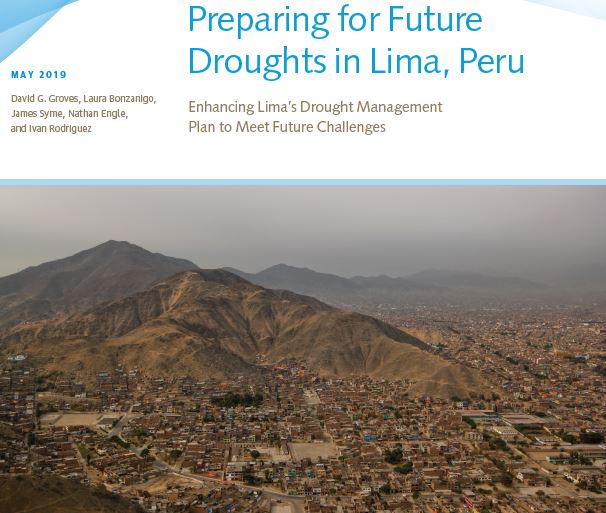Preparing for Future Droughts in Lima, Peru Enhancing Lima’s Drought Management Plan to Meet Future Challenges
Lima is the capital of and largest city in Peru, with an estimated population of about 10 million people. SEDAPAL, Lima’s water utility, provides water to most of the metropolitan region. While SEDAPAL is generally able to meet the current needs of its customers and respond effectively to most drought conditions that have been experienced in the past, it faces a number of challenges doing so in the future. A rapidly growing population and expanding city will likely increase demand. Currently available surface and groundwater supplies that SEDAPAL relies on are also just adequate to meet current needs. Changes in these supplies—either long-lasting reductions or variability in supply due to climate change, or more acute or frequent droughts—would challenge SEDAPAL’s ability to manage drought conditions. Recognizing the urgency of Lima’s water situation, in 2013 SEDAPAL developed an aggressive $2.3 billion Master Plan for the years 2015–44 to augment their supply. While the investments identified in the plan will help preserve SEDAPAL’s capability for addressing increasing demand in the future, it did not specifically consider the ability for SEDAPAL to successfully manage future droughts. A previous collaboration between the World Bank and SEDAPAL in 2014–15 evaluated the robustness1 of SEDAPAL’s Master Plan. This previous study focused on long term trends of climate and demand and focused only on the infrastructure investments for increasing supply identified in the Master Plan. This study builds upon the results of the 2015 study by evaluating the performance of SEDAPAL’s current drought management plan against future droughts and proposes augmentations. This study takes a deeper look into the operation of the system, the different triggers, and other possible augmentations than those related to increasing supply. The audience of this report includes SEDAPAL and stakeholders from Lima as well as other water managers and researchers interested in drought management planning methodologies and case studies. SEDAPAL’s current drought management plan includes a set of actions triggered during hydrologically dry periods. We used a model of SEDAPAL’s management system to evaluate how the current drought management plan would perform across a wide range of plausible hydrologic conditions and current and increasing demands. To do so, we developed hundreds of different futures reflecting different assumptions about how the intensity and frequency of dry and wet conditions might change over the coming decades. We then simulated the performance of the current and enhanced SEDAPAL system under these different futures. This study is novel, as it uses a methodology called Decision Making under Deep Uncertainty to explore uncertainty in near-term drought management conditions and to identify drought management strategies robust to these uncertainties. The approach is participatory and iterative, and we worked closely with SEDAPAL planners and operational teams to develop a suitable systems model of the SEDAPAL system, define useful plausible futures, performance metrics, and infrastructure and drought management strategies.
